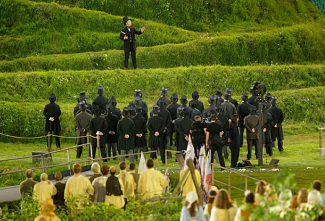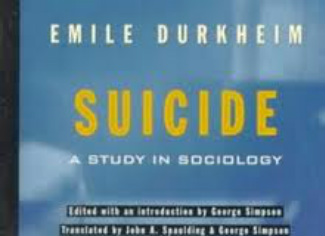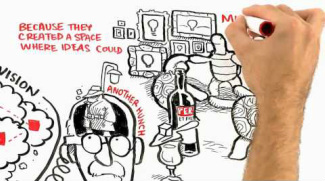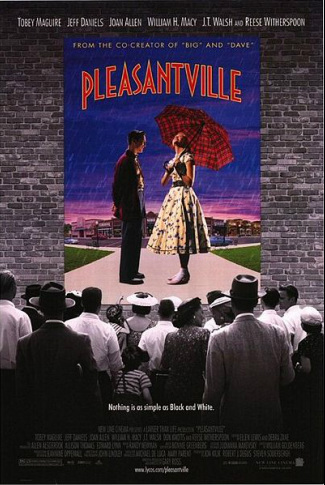 Sociologist Nicholas Christakis discusses structure, agency, and the concept of emergence Sociologist Nicholas Christakis discusses structure, agency, and the concept of emergence Tags: durkheim, emotion/desire, methodology/statistics, organizations/occupations/work, science/technology, theory, adam smith, agency, artificial social network, centrality, collective identity theory, emergence, georg simmel, human capital, methodological holism, methodological individualism, natural social network, nicholas christakis, obesity, social capital, social network analysis, structure, suicide, transitivity, subtitles/CC, 21 to 60 mins Year: 2011 Length: 56:35 Access: YouTube Summary: In this nice introductory lecture to the discipline of sociology, physician and sociologist Nicholas Christakis explodes the popular myth that people are masters of their own destiny. As the YouTube blurb states, "If you think you're in complete control of your destiny or even your own actions, you're wrong. Every choice you make, every behavior you exhibit, and even every desire you have finds its roots in the social universe." 1. This insight is an expression of a fundamental tension explored in the discipline—that between the power of individual agents (i.e., agency) and the power of supra-individual forces (i.e., structure), such as the neighborhood in which one lives or one's location within a social network. 2. The second big idea Christakis explores in his lecture is emergence, or that society is something more than simply the sum of its individuals and that collective phenomena are not mere aggregations of individual phenomenon. To illustrate the concept of emergence, Christakis embarks on a discussion of social networks and other central concepts to the discipline, such as social capital. He then concludes his lecture by pointing out that while many scientific disciplines have broken up phenomenon into smaller and smaller bits, and are now engaged in an effort to put the pieces back together in order to discern how their assembly gives rise to new, emergent properties, this pattern of disassembly and reassembly has always been a central feature of sociological work. Submitted By: Lester Andrist
1 Comment
 Mormons are questioning if their religion was created by society. Mormons are questioning if their religion was created by society. Tags: culture, durkheim, religion, social construction, theory, integration, mormonism, 00 to 05 mins Year: 2013 Length: 4:41 Access: New York Times Summary: In The Elementary Forms of Religious Life, Émile Durkheim (1912) explains the social significance of religious life. He argues—“the universal and eternal objective cause of … religious experience … is society”; and—“that which makes a man is the totality of the intellectual property which constitutes civilization, and civilization, is the work of society.” In other words, religion is created by society, and that its beliefs and what it constitutes as "sacred" are a product of human meaning and culture. In this video, we see Hans Mattsson, a former high-ranking leader within the Mormon Church in Europe, coming to terms with the notion that his religion may have been constructed by society (Mattsson is one of a growing group of disbelievers in the Mormon church). It notes that the Church of Jesus Christ of Latter-day Saints (i.e. the Mormon Church) has always taught that The Book of Mormon is factually and historically true, but its claims have recently been contradicted by a variety of evidence. Evidence also shows the Church's founder (Joseph Smith) had intimate relationships with many wives, some of whom were very young, casting further doubt within its adherents. As noted in the accompanying NYT article. "The church was born in America only 183 years ago, and its founder and prophet, Joseph Smith, and his disciples left behind reams of papers that still exist, documenting their work, exposing their warts and sometimes contradicting one another." But the Roman Catholic Church, on the other hand, has had over 2,000 years to work through doubts raised by insiders and outsiders. This more recent example, therefore, might serve as a metaphor to think about how all religions (as argued by Durkheim) are constructed by society. Viewers are encouraged to consider how religions are constructed by people, and following Durkheim, what social conditions are necessary for the development of any religion? (Durkheim argues the necessary conditions are the separation of sacred from profane, beliefs, rites, and a church or single overarching moral community.) In addition, the video illustrates Durkheim's concept of integration, or the degree to which collective sentiments are shared and have social relations which bind individuals to a group. Durkheim argued that too much integration or too little integration is damaging to the individual and we see this when Mattsson's integration is lost. In the accompanying article, Mattsson is quoted as saying "Everything I’d been taught, everything I’d been proud to preach about and witness about just crumbled under my feet. It was such a terrible psychological and nearly physical disturbance.” When Mormons expressed such doubts, they were often cut off from friends, family, and leadership within the church—thereby illustrating a social cause for their individual psychological predicament. Submitted By: Paul Dean  Tags: crime/law/deviance, durkheim, theory, anomie, collective conscience, functionalism, mechanical social sanctions, norms, 00 to 05 mins Year: 2012 Length: 1:14 Access: YouTube Summary: Deviant acts are transgressions of social norms. For instance, when a woman uses the urinal in the men's restroom she is clearly breaking a social norm. Her transgression is an act of deviance. But people break rules all the time. Norms after all are only informal directives for action, and humans aren't programmable. In some cases, norms are accidentally broken, and in other cases, they are purposely broken by a rebellious actor, who is unafraid of the potential sanctions. In still other cases, social actors improvise to redefine the situation, thereby temporarily changing the set of applicable norms. For instance, the bathroom bound woman may signal verbally or through her body language that in order to avoid an embarrassing public scene she needs immediate access to a toilet, which just happens to be available in the men's room. By redefining the situation as an emergency, she gains access to the men's room. Norms are relatively malleable, but once they are codified as laws, much of this malleability is lost. Breaking a law is no less an act of deviance, but this particular type of transgression is known as a crime. Unlike norms, laws are generally more difficult to circumvent, and the formal social sanctions applied to law breakers are far more severe. The above clip features a school bus driver's amateur footage of an impatient woman illegally zooming past his bus' stop sign. In this unambiguous criminal act of deviance, she drives her car on a sidewalk next to the bus, just in front of a daycare center. Note the glee in the voices of the school children, who watch as the woman is stopped by a police officer who witnessed the entire event. In addition to catalyzing a conversation about deviance, norms, and law, the video can also be drawn on to discuss Durkheim's insight that just as this woman's crime seems to have improved the solidarity among children in the bus, crime in general can paradoxically improve the social solidarity within a society. In this case, the woman's $500.00 fine can be understood as a mechanical social sanction. It is an opportunity for those who witness and hear about the event to unite in their shared disgust over the brazen disregard for laws designed to protect the lives of children, and it's an opportunity to further promote the sacred values of the community. Submitted By: Lester Andrist  A scene from the 2012 Olympic Opening Ceremony. Tags: capitalism, class, durkheim, economic sociology, marx/marxism, organizations/occupations/work, theory, weber, alienation, disenchantment, mechanical and organic solidarity, species-being, 11 to 20 mins Year: 2012 Length: 20:00 Access: YouTube (start 13:40; end 33:40) Summary: The London 2012 Olympic Opening Ceremony focused in part on the Industrial Revolution which is seen to be pioneered by both the British and Europeans in the 19th Century. The ceremony opens with England depicted as a meadow, showing its agricultural past, then continues by depicting the industrial society that followed. This clip can be useful for illustrating many sociological concepts, such as Durkheim’s concepts of mechanical and organic solidarity; Weber’s concept of disenchantment; Marx’s concepts of a two class system, species-being, and alienation; and with the presence of the Suffragettes in the latter part, the clip can be used to introduce Feminist Perspectives. For example, Marx’s concept of species-being (the naturalness of human’s creativity and interaction with nature) is evident in the previous feudal/agricultural society, where the actors are seen enjoying nature and creative activities symbolic to the UK (such as cricket and Maypole dancing), interacting with family and friends, and partaking in ‘productive activity’ which they can relate to, e.g. farming and creative work. However, the people become alienated from their species-being through the era of industrialization. As capitalism developed, workers experienced alienation from their ‘productive activity’; alienation from the ‘product’; alienation from other workers; and alienation from their own creative ‘human potential’. This is shown in the video through the factory work occurring with greater numbers of workers, but with no contact among these workers with each other, working in unison like machines on products that they have no relation to and unable to express any form of human creativity. Viewers might also consider what is missing from the clip, such as colonialism, as well as the race and ethnicity of the actors (as compared to colonized subjects). Submitted By: Michelle MacDonagh  Sean Dorrance Kelly explains why the Super Bowl is sacred Sean Dorrance Kelly explains why the Super Bowl is sacred Tags: durkheim, religion, theory, profane, sacred, 06 to 10 mins Year: 2011 Length: 6:48 Access: colbertnation.com Summary: While Émile Durkheim is known as a founding father of sociology, much of his work has anthropological elements. Many of his theories are based on the assumption modern societies have more evolved and complex versions of the same social attributes that are also found, and more easily visible, in “primitive” or pre-modern societies. One of his most well-known examples comes from the ways many pre-modern societies used religion to differentiate the sacred and the profane. The profane is the routine and seemingly unimportant elements of everyday life whereas sacred things are both idealized or beyond reproach, and bond people together through a collective morality. But since religion plays a less central role in modern life, helping students identify what sacred things bond us together in our own modern society is difficult. However, in this clip from The Colbert Report, philosopher Sean Dorrance Kelly explains how sacred aspects of modern societies still exist in places that often seem profane—like The Super Bowl. Submitted By: Jason T. Eastman  Emile Durkheim's famous sociological study of suicide Tags: durkheim, theory, integration, regulation, suicide, 00 to 05 mins Year: 1992 - 2011 Length: 1:44 - 5:33 Access: YouTube (PJ Jeremy Music Video, 1992, 5:33) YouTube (Heaven's Gate Cult, 2008, 3:01) YouTube (Jobless Veterans, 2011, 1:44) YouTube (College Student, 2010, 2:16) Summary: In his classic book, Suicide, Durkheim argued that suicide can be explained by social, rather than psychological or biological phenomena. Drawing upon a variety of statistics (i.e. "social facts"), he explained suicide as resulting from 4 different social causes (e.g. too much or too little integration in society, and too much or too little regulation by society). Integration is the degree to which collective sentiments are shared and have social relations which bind individuals to a group. Regulation is the degree of external constraint on people, including normative or moral demands on an individual in the group. First, egoistic suicide results from too little integration in society. Individuals lack integration within a collective conscience, are missing social relationships which bind them to the group, and thus have unmet needs and personal dissatisfaction. Pearl Jam's video, Jeremy, depicts the egoistic suicide when, at the end of the video, an isolated and tormented child commits suicide in front of his class. Second, altruistic suicide results when integration is too high and a person is almost forced into committing suicide. This includes members of religious cults or the infamous Heaven's Gate cult (see video) that give their lives willingly to the group. Third, anomic suicide occurs when regulation is too low and individuals experience a state of normlessness or rulelessness. This usually happens when the regulative powers of society are disrupted, and the collectivity temporarily loses its authority over individuals, such as after someone suddenly experiences a divorce or unemployment (see Jobless Veterans video). Durkheim had almost nothing to say about the fourth type of suicide, fatalistic suicide, which results from excessive regulation (no video available). This occurs when "persons with futures pitilessly blocked and passions violently choked by oppressive discipline" (Durkheim 1897: 276), such as when a slave may commit suicide. My best class discussions centered around this tragic video of a gay college student who committed suicide after his sexual activity was broadcast on the internet. His suicide may be understood as an experience of an isolated gay male in a hetero-normative culture. While the news video depicts his suicide resulting from his loss of privacy, Durkheim may suggest he lacked integration within society's collective conscience and accepting social relationships, which might have bound him to the collectivity. Note that this integration is promoted later in the video through the work of Dan Savage's "It Gets Better" campaign (the video also notes that gay kids are 4 times more likely to commit suicide, a "social fact"). Submitted By: Paul Dean  Steven Johnson explains the source of good ideas Tags: community, durkheim, knowledge, organizations/occupations/work, science/technology, theory, creativity, innovation, liquid networks, sociological perspective, steven johnson, 00 to 05 mins Year: 2010 Length: 4:07 Access: YouTube Summary: What is sociology? In broad terms, sociology is the study of society. However, this answer is often unclear or unsatisfying to an incoming class of Sociology 101 students. This clip illustrates Steven Johnson's theory of where good ideas come from, and can help explicate to students what makes the sociological perspective so unique. Instructors can begin by saying that, while most anything can be studied from a sociological perspective, some sociologists have strategically selected sites of inquiry that, at first glance, appear thoroughly individualistic in nature. This strategy is an effort to illuminate how social forces shape even the most seemingly personal of phenomena. Here, instructors can point to Émile Durkheim's study of suicide as a particularly famous disciplinary example of this (which will likely be covered later in the semester). Using a similar strategy, instructors can use the example of creativity and "good ideas" to show how social forces have a profound impact on innovation, a phenomenon that, like suicide, is often characterized as a quintessentially individual act, largely informed by psychological forces. Although some people approach creativity from a psychological viewpoint (e.g., see here), the sociological perspective can be brought into focus for students by comparing such individualistic accounts to Johnson's concept of liquid networks and his use of historical evidence to show the importance of social connectivity and collaboration for innovation. Johnson stresses the need for interconnected social spaces, organizations, and systems for the cultivation of good ideas. Johnson presents a slightly elaborated version of this argument in his TEDTalk. For other clips on The Sociological Cinema that use illustration techniques to convey theoretical arguments, click here and here. I would like to thank Open Culture and Brain Pickings for suggesting these clips. Submitted By: Valerie Chepp  Tags: crime/law/deviance, durkheim, gender, theory, anomie, family, in-groups, out-groups, social change, subtitles/CC, 61+ mins Year: 1998 Length: 124:00 Access: no online access (trailer here) Summary: The film Pleasantville depicts an idyllic 1950's community that experiences profound challenges to its unquestioned, taken-for-granted social norms. The movie works well in an introductory sociology class as an allegory about a settled or stable society that undergoes rapid social change following a major disruption in the worldview and widespread norm breaching. Specifically, the film depicts challenges related to the use of language, modes of communication, family formation, sexual norms, social deviance, art, and media. I recommend using the film in its entirety to demonstrate how in-groups resist change, while out-groups often challenge norms and produce positive (or negative) adaptations to society. One could also use segments of the film to demonstrate concepts like alienation, anomie, and deviance. Submitted By: Michael Gillespie  Bill Clinton describes global society in functionalist terms Tags: durkheim, theory, globalization, interdependence, structural functionalism, 00 to 05 mins Year: 2009 Length: 3:25 Access: YouTube Summary: Durkheim saw society as functioning like an organism with many inter-dependent parts, and he often referred to biological organisms as a metaphor for the functioning of society. This is demonstrated here with Bill Clinton's interview on Larry King Live, where Clinton defines global society by its "interdependence" and our commonalities. He even links human society to our similarity in DNA: "we don't have time to obsess about our differences any more...genetically we are all about 99.9% the same...from a political and social point of view that doesn't amount to a hill of beans." Note that the entire clip is 4:50, but the relevant section on interdependence ends at 3:25. Submitted By: Margaret Austin Smith |
Tags
All
.
Got any videos?
Are you finding useful videos for your classes? Do you have good videos you use in your own classes? Please consider submitting your videos here and helping us build our database!
|
 RSS Feed
RSS Feed
